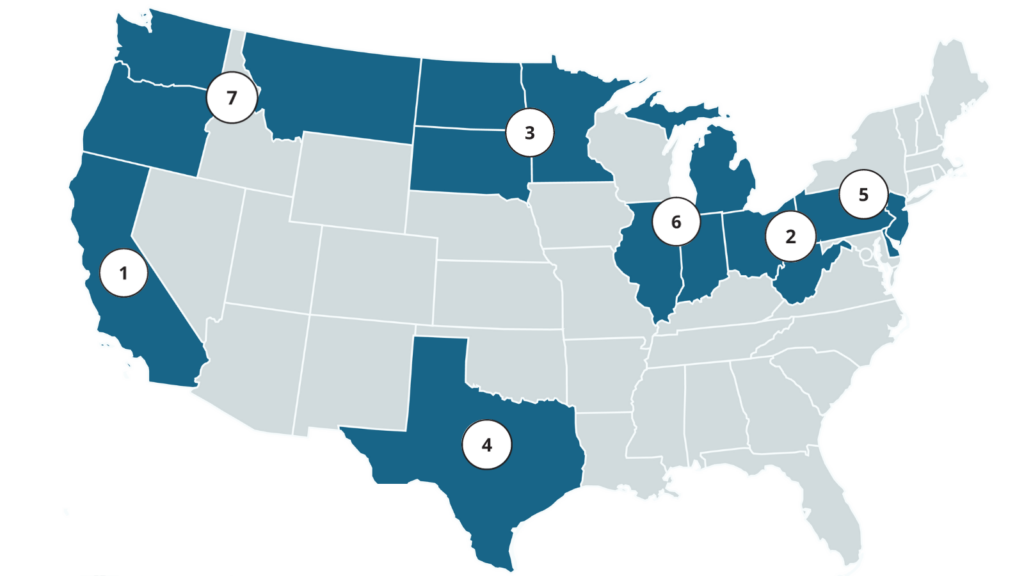
NCEL Blog
Hydrogen Hubs Have Been Selected: What Next?
November 28, 2023
How to evaluate the selected hubs and what state legislators can do to improve them?
This blog was written in partnership with NRDC.
The Biden Administration has selected 7 regional hubs to each receive approximately $1 billion of federal funding to build a hydrogen hub.
- Deeper Dive: What is a hydrogen hub? A network of producers, consumers, and needed infrastructure to streamline the deployment of clean hydrogen as a climate solution for hard-to-decarbonize sectors like heavy-duty transportation and industry.
This is a huge opportunity to develop an important climate tool, create good clean energy jobs, and improve the health of our communities. However, it also carries risks that could make any of these issues worse.

What Makes a Hub Clean and Equitable?
- New, Near, and Now: Electrolytic production relies on clean energy that is new, near, and now. This means that it complies with the 3 pillars of new supply, hourly matching, and geographic deliverability. The three pillars are necessary to avoid adverse climate, health, and consumer impacts from hydrogen production.
- High-Value: Prioritizes high-value end uses that are hard to electrify like steel, shipping, and aviation. Hydrogen use in applications that have more efficient and low-cost clean energy solutions – notably, buildings, light and medium duty transportation, and the power sector – is minimized or altogether avoided. To the extent that hydrogen is used to generate electricity, it is limited to narrow services such as seasonal storage of power.
- Mitigate Air Pollution: Any air quality impacts of hydrogen combustion (i.e. NOx emissions) for electricity generation are mitigated such that NOx levels are, at a minimum, improved relative to the status quo.
- Engagement: Robust, transparent, and collaborative engagement, early and frequently, with impacted communities. Engagement should not only be to inform and seek input from communities, but ensure their voices are represented within decision-making processes and structures before and throughout project development.
- Robust Community Benefits Plans Hubs whose Community Benefits Plans (CBPs) identify all potentially impacted communities, the potential negative impacts of the projects, and how developers will work to address and mitigate these effects.
- Project Benefits: Hubs whose CBPs explicitly outline trackable, measurable project benefits, and explain how they align with the impacted community’s priorities and the Department of Energy’s eight Justice40 policy priorities.
Potential Risks of Hydrogen Hubs
- Over-reliance on Fossil Fuel-Derived Hydrogen with Carbon Capture and Storage (CCS) – This carries risks for the climate and local communities that are inherent to fossil fuels. Where it is being considered, it should be held to strict scrutiny and high climate and health standards, including:
- Very low upstream methane leakage rates of less than 1%, verified via in-basin measurements – as opposed to inaccurate on-paper averages;
- The capture and permanent sequestration of at least 90% of carbon emissions;
- Producers are required to adopt best-in-class pollution control measures and technologies. Communities who will live in proximity to those projects must be fully informed of the potential harmful health impacts of gas extraction and use. Through early and frequent engagement, developers must work with communities to identify their concerns and mitigate project impacts accordingly.
- Relying on Existing Clean Energy Sources: Electrolytic hydrogen production powered by existing clean energy sources (e.g., hydropower and nuclear) that leads to an increase in grid emissions and fossil-fueled electricity.
- Wasteful End Uses: Significant use of hydrogen in wasteful end uses, like blending into natural gas distribution networks or power plants, and most road transportation uses – which have far lower-cost and more efficient clean energy alternatives.
- Lack of Community Engagement: Failure to engage with impacted communities throughout the Hub implementation process and very limited transparency and information sharing.
- Ineffective CBPs: Hubs whose CBPs fail to adequately identify all impacted communities, the potential negative impacts of the projects, and how they will address and mitigate those impacts.
- No Tracking of Project Benefits: Hubs whose CBPs do not outline trackable, measurable project benefits, or fail to explain how they align with the impacted community’s priorities and the Department of Energy’s eight Justice40 policy priorities.
Next Steps of the Hub Process
The selected hubs are now in negotiations with the Department of Energy over the terms of their funding agreement before money is released for phase, which is a planning phase. That means there is still a large opportunity to shape the hubs over the negotiation stage and phase 1, making now a critical time to engage.
Ways State Legislators Can Improve Your Hub
- Call on your Governor to release more information about the hub’s plans, and to align them with climate goals by ensuring truly clean hydrogen is paired with high-value end uses.
- Introduce legislation to:
- Create a state incentive program that will only pay out if critical climate guardrails are met on production standards (three pillars for electrolytic production, accurate methane and carbon accounting, and high carbon capture rates) and is targeted to hard-to-electrify end uses. See Colorado HB1281 for an example.
- Require robust community engagement and environmental justice considerations in the development of the hub.
- Ban hydrogen blending into gas distribution networks.
- Push for a workforce development model that will prioritize environmental justice communities that suffer from legacy industrial pollution and those living alongside the new hydrogen projects.
- Advocate for accurate and climate-aligned rules for the federal 45V tax credit, which almost all hub projects are expecting to receive. This could be through your governor or hub administrator. See hub contact information linked here.
State legislators have a key role to play in ensuring that their state’s hydrogen hub is clean, equitable, efficient, and an economic benefit to their constituents. More information about each hub will be forthcoming in the coming months. Contact Climate & Energy Manager, Ava Gallo, for more information on how to stay engaged.